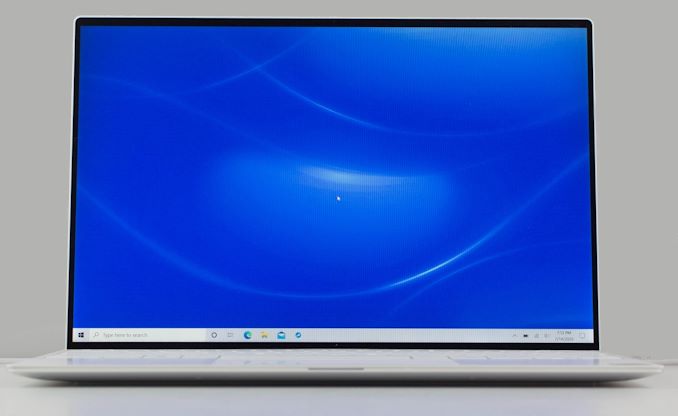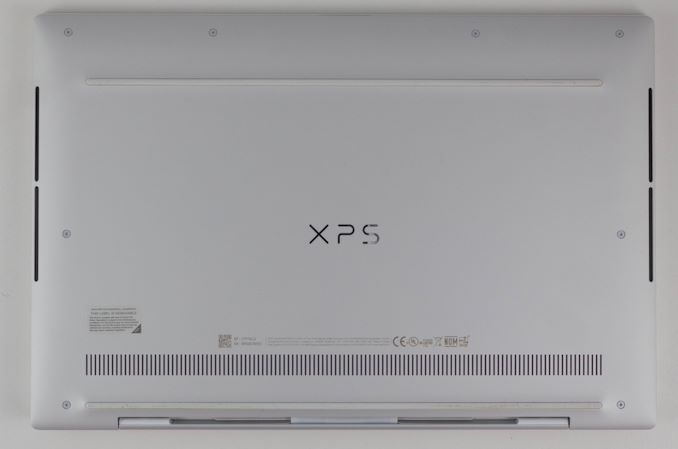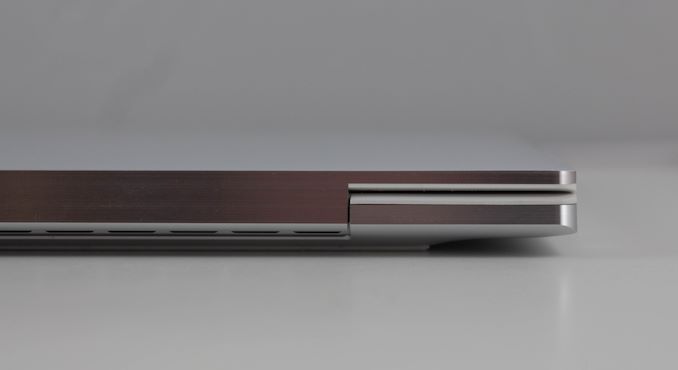The Dell XPS 13 (9300) Review: Return of the King
by Brett Howse on July 16, 2020 10:00 AM ESTFinal Words
Dell’s XPS lineup is one of the strongest in the PC industry. The InfinityEdge display was a revolution, allowing laptop sizes to shrink considerably, while providing the same display size. The new XPS 13 improves on an already excellent pedigree by moving to a 16:10 aspect ratio on the display which further reduces the bezel and keeps the new XPS 13 looking as fresh as ever.
The two color choices are both great, but the Arctic White, with its woven fiber keyboard deck, is really striking. Dell has tweaked this slightly from their original 2-in-1 design by moving back to black display borders, which can help hide the admittedly small bezels even further. The older soft-touch carbon fiber black color is still a great look as well. The refreshed XPS 13 is simply one of the nicest looking notebooks in its class.
The move to Ice Lake in the 2020 refresh is also a welcome addition, mostly thanks to the significantly improved integrated GPU performance, but also because it allows the laptop to support 32 GB of RAM. Coupled with the maximum 2 TB of SSD storage, and the XPS 13 offers plenty of performance for its size. There will be those that lament the lack of an AMD option, as AMD’s latest Renoir is a very potent platform, but the lead time on a notebook like this would preclude that option.
Dell’s decision to move to a 16:10 aspect ratio means that you get a bit more vertical space, which should be beneficial in most productivity scenarios. Of the two display options, unless the wider P3 gamut support of the 3840x2400 display is something critical for a specific workflow, the extended battery life of the 1920x1200 is likely the better option for most people. And, just so it is not forgotten, Dell’s anti-glare coatings are a shot in the arm for the PC industry, providing just 0.65% reflectivity, and when coupled with the very bright display, makes for a winner in almost any lighting condition.
Even the bottom of the XPS is well thought out. Torx screws surround the bottom which allow access inside if needed, and Dell continues to utilize rubber feet which span almost the entire width of the notebook, providing an incredibly solid footprint across a range of surfaces.
Open or closed, the XPS 13 is a fantastic looking device. It backs that up with excellent performance, and plenty of options to fit almost any budget. It is somewhat rare for a premium notebook to start at under $1000 USD, but Dell manages that, if only barely, but the base model now provides 8 GB of RAM and 256 GB of storage, which is much better than some of the XPS 13’s of old, which started with half that RAM and storage for the same price. Dells options are also very reasonable priced, so upgrading from the base model does not instantly launch the price into the stratosphere.
It is great to see Dell update their XPS 13 clamshell notebook to the same internals and design of their previously released 2-in-1 version. It is also great that you can opt for either the clamshell XPS 13, or the convertible 2-in-1, depending on your needs. The convertible offers some increased functionality that you cannot get in a traditional notebook, but there is also a large market that prefers the simplicity of the traditional design. With the XPS lineup, it is your choice.
Finally, in a very rare move, Dell offers not only Windows, but also Linux, giving buyers their choice on what operating system they get. It goes without saying that this is an incredibly uncommon thing on a premium notebook, and very welcome to see. In the case a buyer does opt for Linux, then the the XPS 13 Developer Edition, as it's called, comes from the factory with Ubuntu 18.04LTS.
Overall there is a lot to like about the new XPS 13, and very little to detract from. Dell has yet another winner. With an updated 16:10 display, class-leading battery life, and a fantastic design, the XPS 13 is easily one of the best notebooks around.














224 Comments
View All Comments
serendip - Friday, July 17, 2020 - link
Surface models are the only mainstream computers to use a 3:2 ratio. I think 16:9 is only good for media consumption.cerfcanuck - Thursday, July 16, 2020 - link
Whenever I hear "soft-touch finish", I always wonder about long-term durability. In my experience (admittedly not with recent Dell products) such finishes have either scratched easily and/or turned "gummy" over time. Is this still a problem?willis936 - Thursday, July 16, 2020 - link
I have had an XPS 13 9343 for five years and the soft touch materials don’t feel aged. Five years isn’t very long term, but it’s a data point.I doubt these will go the way of the early 2000s mice that require a thorough hand wash after use.
Byte - Friday, July 17, 2020 - link
My lenovo Yoga 1 had softer touch. Its pretty thick. It did not get gummy but it is peeling off. Which is better than gummy I guess. About 8 years old.Retycint - Friday, July 17, 2020 - link
The soft touch did not age well for my XPS 15 9560. Gotten extremely sticky and started to peel off around 2 years in - this was of course not covered under warranty as it was considered "wear and tear".Context: I live in a tropical and humid country which probably accelerated the deterioration, so your experience may vary.
s.yu - Saturday, July 18, 2020 - link
My 2019 XPS 13 2N1 has this finish and leaves me wondering every time after I use the palm rest if I should wipe it with water, with alcohol, or just leave it. Good thing I often use it in tent mode(a must for stylus use) and use a BT keyboard, which sidesteps the whole issue.There is a tiny flaw on the finish though, it's a dent less than 1mm in diameter that looks like what's left of a burst bubble of a highly viscous fluid on a flat surface.
s.yu - Saturday, July 18, 2020 - link
Oh, FWIW I have a USB charger I bought about 6 years ago that claimed a "babyskin" finish, which feels similar to this "soft-touch" finish, I'm guessing some people really thought it's made of the skin of babies is why they dropped the name. It's often under somewhat high temperatures since it's a charging brick and it's softened with some wear at the corners, but it's only very slightly sticky.raystriker - Thursday, July 16, 2020 - link
Wonder if most of the premium ultrabooks will have an AMD offering by next year?eek2121 - Thursday, July 16, 2020 - link
Doubtful. Intel is very competitive in the mobile space and Tiger Lake is apparently dropping in September.Walkeer - Thursday, July 16, 2020 - link
what exactly do you mean by "very competitive in the mobile space"? more bugs? more power consumption? way less performance?